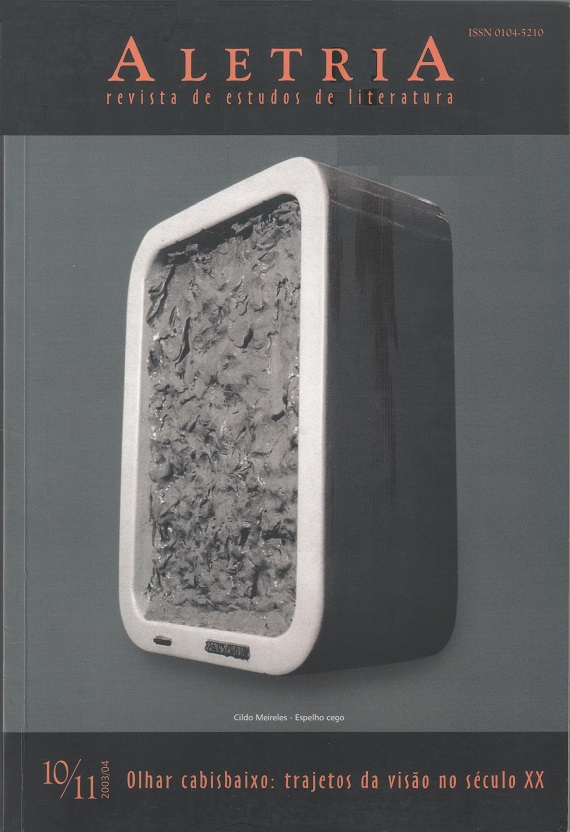A rebelião das máquinas: a arte na era da comunicação aparativa
DOI:
https://doi.org/10.17851/2317-2096.10..144-159Palavras-chave:
arte, técnica, mediatização, art, technique, mediatization.Resumo
Resumo: O presente artigo contribui para uma reflexão sobre a influência da técnica sobre as artes na Era da Informatização. Desde o início da Era Industrial, nota-se a inversão gradativa de papéis entre máquina e homem: a "ascensão das máquinas" teria transformado o homem em "servo". Nem mesmo o campo das artes esteve livre dos efeitos de tal "ascensão", sobretudo no contato com os meios de comunicação de massa, como o rádio, o cinema e a televisão. Na verdade, tudo não passou de um prelúdio para o que ainda estava por vir: a informática atingiu as artes e nossa cultura fundada na tradição escrita, resultando em transformações muito mais amplas no âmbito da comunicação individual e social.
Palavras-chave: arte; técnica; mediatização.
Abstract: The present article brings up issues on the influence of technique on art in the Information Age. Since the beginning of the Industrial Age, there has been a progressive inversion of roles in the relation between man and machine : the "rise of machine" seems to have turned man into a "servant". Not even the field of art remained untouched by the effects of such "rise", specially in its contact with communication media like radio, cinema and television. In fact, all that was but a prelude to what was still to come: informatics reached into the arts and our writing based culture, causing widespread transformations in the realms of social and individual communication.
Keywords: art; technique; mediatization.
Downloads
Referências
ANDERS, Günther. Die Antiquiertheit des Menschen. Bd. 1 (zuerst 1956). 6. Aufl. München, 1983.
BELLAMY, Edward. Looking backward 2000-1887. Boston, 1888.
BELLAMY, Edward. Ein Rückblick aus dem Jahre 2000 auf 1887. Georg von Gizycki u.d. T. Stuttgart, 1983.
BENJAMIN, Walter. Das Kunstwerk im Zeitalter seiner technisch en Reproduzierbarkeit. In: Illuminationen. Frankfurt a. M., 1969.
BIRKERTS, Sven. TransAtlantic, edição online do Atlantic de 10 set. 1998.
EIMERT, Herbert. Epitaph für Aikichi Kuboyama. Komposition für Sprecher und Sprachklange. Tradução da epígrafe para o alemão: Günther Anders. 6 Studien. Koln: Studio für elektronische Musik im Westdeutschen Rundfunk. Wergo Schallplattenverlag Baden-Baden: 1962. republicado em CD: Koch/Schwann 1996.
FREYERMUTH, Gundolf S. CyberArt Now! Kunst wird spannend: Cyberartisten gestalten den Datenraum. Magazin für Computer technik 1998. Caderno 17, p. 76-81.
HUYSMANS, Joris-Karl. Là-Bas (primeiro 1891). Paris: Plon, 41. Éd., 1921.
LEVINE, Bettijane. Can't curl up with a Cyberbook? Think again. Los Angeles Times, 4 set. 1998.
LORENZ, Dagmar. Der Cyberschreiber und sein Golem. Mark Amerika erfindet Literatur im Internet neu. DIE ZEIT, Nr. 16, 8 abr. 1998, p. 77.
PFLUGRADT, Elke. Maschinenerotik bei van de Velde, Scholz, Klapheck. In: Die nützlichen Künste, ed. por Tilman Buddensieg e Henning Rogge. Berlin 1981, ilustração, p. 375 e 376.
ROLLAND, Romain: La révolte des machines ou la pensée déchainée. Paris, 1921.
SARTRE, Jean Paul. Critique de la raison dialectique I. Paris, 1960.
SIMMEN, René (Org.). Der mechanische Mensch. Texte und Dokumente über Automaten, Androiden und Roboter. Zürich, 1967.
Downloads
Publicado
Edição
Seção
Licença
Copyright (c) 2003 Eberhard Lammert (Autor)

Este trabalho está licenciado sob uma licença Creative Commons Attribution 4.0 International License.
Autores que publicam nesta revista concordam com os seguintes termos:Autores mantém os direitos autorais e concedem à revista o direito de primeira publicação, com o trabalho simultaneamente licenciado sob a Licença Creative Commons Attribution que permite o compartilhamento do trabalho com reconhecimento da autoria e publicação inicial nesta revista.Autores têm autorização para assumir contratos adicionais separadamente, para distribuição não-exclusiva da versão do trabalho publicada nesta revista (ex.: publicar em repositório institucional ou como capítulo de livro), com reconhecimento de autoria e publicação inicial nesta revista.Autores têm permissão e são estimulados a publicar e distribuir seu trabalho online (ex.: em repositórios institucionais ou na sua página pessoal) a qualquer ponto antes ou durante o processo editorial, já que isso pode gerar alterações produtivas, bem como aumentar o impacto e a citação do trabalho publicado (Veja The Effect of Open Access).














